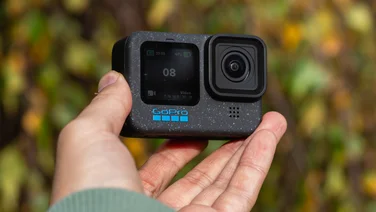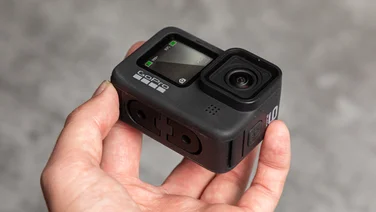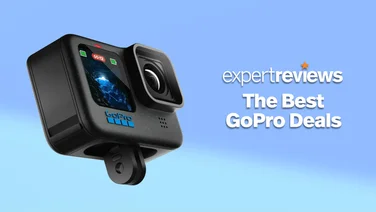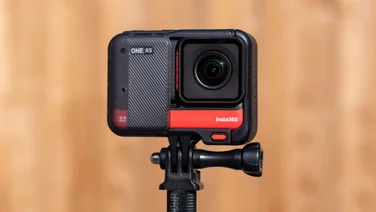To help us provide you with free impartial advice, we may earn a commission if you buy through links on our site. Learn more

Clearly aiming its sights at the GoPro Hero4 Black, Sonys FDR-X1000V is a tiny action cam that’s capable of 4K recording. Just like the Hero4 Black, the FDR-X1000V can manage 4K (3,840×2,160) at up to 30fps. However, Sony’s pint-sized device is able to record 4K at much higher bit rate compared to the GoPro, with either 60Mbit/s or 100Mbit/s recording. The GoPro, on the other hand, tops out at 60Mbit/s, making the Sony look very impressive on paper.
However, in order to record 4K at either bit rate, or even high bit rate 1080p video, the FDR-X1000V is very particular about the type of microSD card you use. It will need to be rated both Class 10 and UHS 3 to enable the higher bit rate recording options, so you’ll need to factor this in when you come to buy one.
The camera will also accept M2 memory sticks, but both types of card have to be installed in the same slot. This means that microSD cards can be inserted the wrong way round, after which the camera will give you a media error, so youll need to make sure youve installed it properly before you attempt to start recording. As M2 memory sticks are so much more expensive than microSD, chances are youll want to use the latter.

Design and Remote
The design of the FDR-X1000V isnt a massive departure from the HDR-AZ1 I reviewed last year. Its quite a bit taller, which lets it sit much more comfortably in your hand like a traditional camcorder, but given its miniscule proportions I imagine that most people will end up mounting the camera rather than holding it.
Otherwise, the FDR-X1000V comes in the same glossy white finish as the HDR-AZ1, a large shutter button on the top and a pair of menu buttons on the side next to its small LCD screen. Keep in mind, though, that the display is purely for changing settings, so you wont be able to use it to frame shots or play back footage.
Instead, you’ll either need to need to use Sony PlayMemories app on your iOS or Android smartphone, or invest in the wrist-based RM-LVR2 live-view remote. The RM-LVR2 can either be bought with the camera (which changes the action cam’s model number to FDR-X1000VR) or purchased separately for £120 direct from Sony.
This slightly unwieldy remote viewer has a colour LCD screen and dedicated shutter button, and it pairs directly with the camera through Wi-Fi Direct. It takes a few seconds to re-pair after you turn the camera or remote off, but the remote can also pair with up to five different cameras, which is useful if youre on a multi-camera shoot and want different angles.
This gives you a feed from the camera sensor, so you can frame your shots and play it back afterwards. The live-view only has a very marginal delay, too, which compares very favourably with many action cameras that pair with smartphones for similar functionality. The remote also lets you change camera settings using the same menu structure as the camera. It’s slightly quicker, but it also has the rather irritating habit of kicking you back out to the main menu whenever you change a single setting. This can make it rather frustrating to use, as most options are found within nested menus and many aren’t where you might think either.

There’s a small LED on the back and another on the top that light up red when recording video. However, only the back LED lights up when you take a photo, so there’s no easy way to tell what mode the camera is in when you’re pointing the camera at yourself. In this case, another light on the front of the camera would have been useful.
Mounts and waterproofing
The FDR-X1000V has a conventional 1/4in tripod thread on its underside, and comes with one of Sony’s adhesive mounts in the box. However, it’s also compatible with Sony’s monopod, chest and head mounts, and you can even buy Go-Pro adaptors for it as well, making it incredibly flexible. Just be wary that the microphone won’t be accessible if you’re using it inside its waterproof housing.
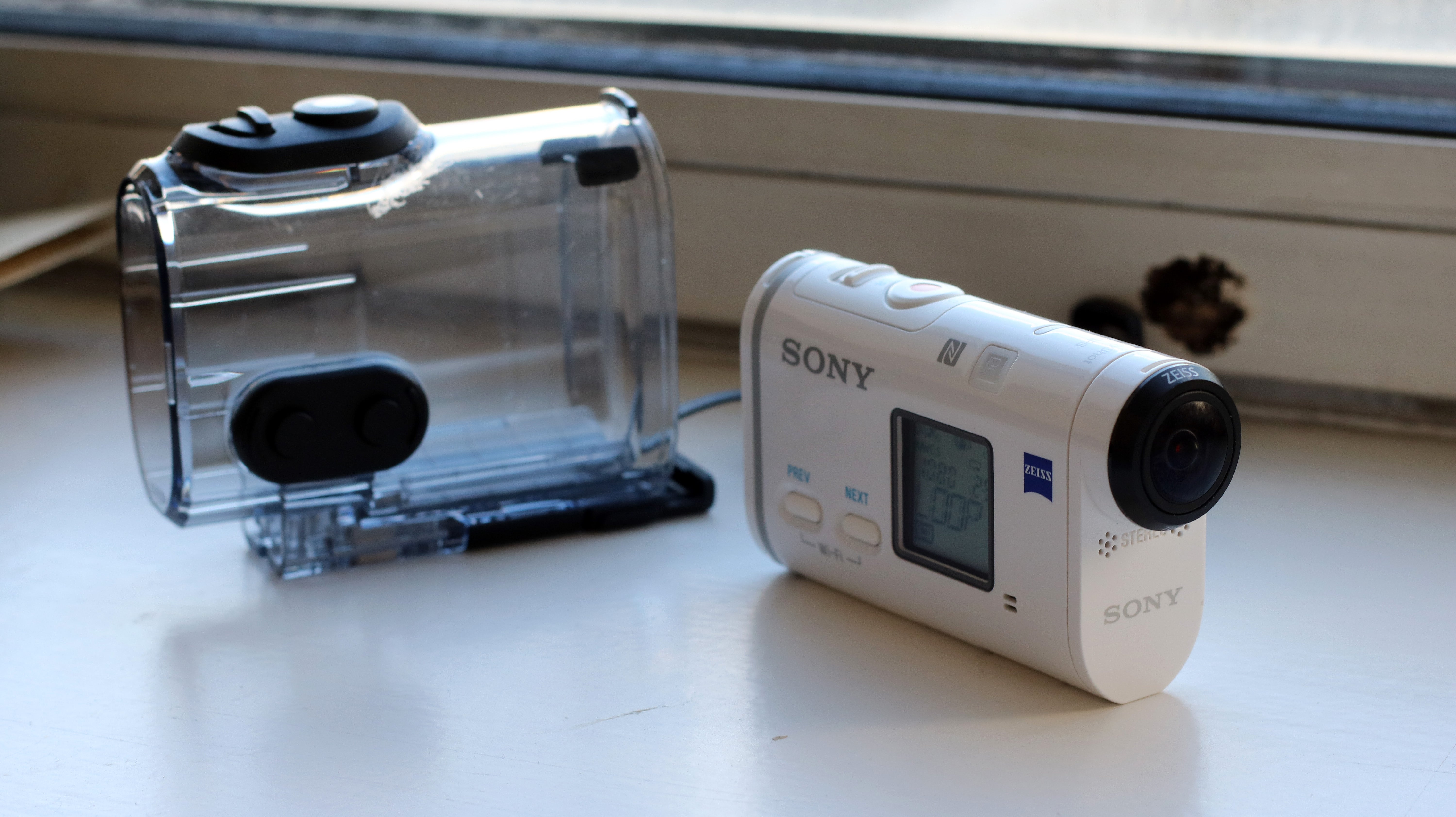
The bare camera is splash-proof, but the FDR-X1000V can survive submersion to 10m when it’s placed inside its case. This isnt particularly impressive when the Hero4 Black can go to depths of 40m, but for around £24, you can buy Sony’s AKA-DDX1 Replacement Dive Door, which will then allow you to go up to 60m.
The top of the camera and waterproof case have a hold slider that can stop you accidentally hitting the shutter button. Otherwise, you can instantly begin recording by hitting the shutter button even when the camera is on standby. It will take about seven seconds to power on and begin recording, so youll still need to plan accordingly but its handy to not have to fiddle with buttons before you can start shooting.
Recording and Modes
In terms of recording modes, you have a wide range of options depending on which recording format you choose. In MP4 format at 1080p, you can record at up to 60fps, while dropping to 720p allows up to 100fps, whereas 240p (800×480) opens up super slow-motion 200fps video.
Theres the aforementioned 4K video at 100Mbit/s or 60Mbit/s and 30fps when shooting in XAVC S format. XAVC is Sonys own video codec, which is incredibly versatile. Using XAVC S, you can record at up to 120fps in 1080p and 240fps in 720p, which is very good indeed.

You can shoot in Loop mode, too, where the camera will continue to record and write over old footage when the memory card becomes full, which is useful if you want to use the action cam as a dash cam in your car. As well as video, you can also capture 8.8 megapixel still images and take timelapse photos at 1, 2, 5, 10, 30 and 60s intervals.
When connected to a suitable Wi-Fi hotspot, you can also broadcast live through UStream. This is especially handy if you turn your smartphone into a hotspot and use your data connection. Youll need to initially connect the FDR-X1000V to your PC and use Sony’s bundled software to add your wireless details and Ustream account, but once this is done you can select the Live option where the camera will connect to the designated Wi-Fi hotspot and begin broadcasting. In testing, this worked without a hitch, something I couldnt say about the 4GEE Action Cam, which was based on this very premise.
Video Quality and Image Stabilisation
On the front of the FDR-X1000 is a Zeiss Tessar lens with an aperture of F/2.8. It has a variable field of view of either 120 degrees or 170 degrees, but the latter introduces a significant amount of barrel distortion. This can be used to stylistic effect if youre looking for that distinct shot on an action camera look, but it’s not best suited to standard footage.
Theres also Sonys SteadyShot image stabilisation, although its worth noting that this isnt available when you shoot in 4K, and its electronic stabilisation rather than optical. This means its achieved by cropping the image down to remove unwanted camera shake, but it’s still better than nothing, as electronic image stabilisation is something thats been missing from GoPros cameras over the years.
^ 4K test footage – no image stabilisationWith the camera mounted on the Expert Reviews image stabilisation test platform, the SteadyShot image stabilisation did an excellent job of reducing low-level vibrations, so its a shame its not available when you shoot in 4K. The SteadyShot is designed to work particularly well with the vibrations from drones, too.
In both 1080p and 4K resolutions, the FDR-X1000V delivers crisp and sharp images around the centre of the frame. It becomes a little soft in the corners but nothing too detrimental. In terms of detail, even though it records with a higher bit rate than the GoPro Hero4 Black, it doesnt quite record as much detail, especially in the shadows.
You have the option of two colour modes, Natural and Vivid. In Natural, colours are too subdued and sombre, meaning that outdoors footage can often look a little drab even in the winter sunshine. Vivid, on the other hand, makes things a little oversaturated. Something in the middle would have been better, but at least you can colour correct when you’re editing the footage back on your PC. Getting it right in-camera is always preferable, however.
^1080p – image stabilisation turned onTheres also GPS built into the camera itself, which is an improvement over the HDR-AZ1 as this could only get GPS data from the optional remote control. This means videos have GPS geolocation data embedded and you can use Sonys editing software to overlay speed information and maps, which could be an interesting additional layer depending on how you intend to use the camera.
The front of the camera has a pair of microphones that record in stereo and these were reasonably sensitive. Theres built-in wind noise reduction, too, and this did an excellent job of cutting down distracting noise when the camera was taken out on a bike ride. As an aside, the Sony handlebar mount wasnt the greatest when it came to reducing the amount of vibrations it picked up, but it’s also a testament to the microphones sensitivity that it could pick up so much sound.

Capturing 8.8 megapixel stills were also respectable. There’s not as much detail as I would have liked in the brickwork from my test photos, but colours were nice and vibrant and there was plenty of contrast. You’ll want to make sure you set the angle to 120 degrees unless you want lots of barrel distortion.
Battery Performance and Connections
The FDR-X1000V has a removable battery, meaning you can carry spares with you on the road. Its battery life was excellent, too. Shooting 1080p, 30fps and 50Mbit/s, I managed to eke out an excellent 2 hours 5 minutes, which is around a half hour longer than the GoPro Hero4 Black at a comparable resolution. Shooting in 4K at 100Mbit/s bit rate and 30fps saw a still very respectable 52 minutes, putting on an equal playing field with the Hero4 Black.
Charging the FDR-X1000V is handled through a Micro USB port on the back, and theres also a Micro HDMI port that can output in 4K so you can watch your high-resolution footage on a compatible display. The M2 and microSD memory card slots are also tucked away behind a waterproof door.
Conclusion
Theres a lot to like about the Sony FDR-X1000V. For the money, its great value for what it delivers and has lots of functions you dont get from a GoPro Hero4 Black, such as image stabilisation and GPS data. In a straight image quality comparison, however, it doesnt match up.
There are other little annoyances, too, such as its fiddly menu system, and in my book this is enough for the Hero4 Black to pull ahead, remaining my 4K action cam of choice. However, if you favour flexibility and really want the GPS data, then the FDR-X1000V is still an excellent choice.

